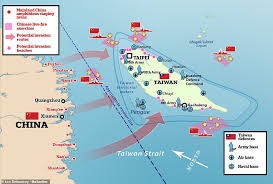
Recently I watched a presentation about the United States military. We face a very real if under-discussed possibility of an attack by China on American forces as a part of an invasion of Taiwan. If you take any stock in what China says and even more importantly what it has been doing, you might want to join the 1% or so of Americans paying attention. Remember when a large majority of the chattering classes thought Vladimir Putin was bluffing when he moved forces all the way from the Pacific region to the border of Ukraine? Best not to be that silly again.
In any case, an analysis concluded that the United States had overinvested in stealth aircraft. Stealth aircraft are great, mind you, but internal weapon bays are essential for stealth but also limit the amount of weaponry a plane can carry. The same goes for external fuel tanks, which extend operational range. Given the large investment made by China in asymmetrical tactics developed in the hope of sinking aircraft carriers, limited range is a big problem.
Not to worry. American advanced technology will save the day! Or will it? The NGAD (Next Generation Air Dominance) sixth-generation fighter might still be on the drawing boards before a major conflict breaks out. American aviation budgets are huge in comparison to other countries, but they are not infinite. The Pentagon needs to juggle keeping old systems operational and optimized while also developing next-generation platforms. We need a new strategy, on a budget, and with platforms we have available to us now.
What to do? The proposed solution involved using stealth aircraft to perform stealthy missions, like taking out enemy radar. Then the thinking went, we should use upgraded versions of older, non-stealthy aircraft. These older platforms are delightfully inexpensive; we have them lying around, and while lacking stealth, they can carry a tremendous amount of ordnance and big fuel tanks. Will it work? Hopefully, we will never have to find out, but this sort of thinking sounds broadly sensible.
What lessons can the school choice movement draw from this? Well in the implementation of ESAs, I’ve been hearing NGAD/major technological breakthrough stories for some time now. In the words of Jim Grant, “the inevitable is certain but is not always punctual.” While it is inevitable that technologies for improving ESA administration will develop, whether we can deploy them fast enough is an entirely different question.
So if like the American military, we need a solution we can implement now with technologies we have on hand and at an affordable cost the answer seems to be: debit cards. An improved version of an ESA debit card, limited to relatively simple purchases like tuition, therapies and tutoring, might relieve pressure on struggling ESA purchasing mechanisms. It might also reduce family frustration. Recently an Arizona ESA parent wrote on Facebook “so we have these accounts, which have money in them, that we can’t use.” The tens of thousands of pending reimbursements and various other payment delays have proven to be deeply frustrating to both parents and vendors.
Debit card codes are readily available to limit where purchases can happen, and practitioners have developed risk-based auditing in other, more mature policy areas such as SNAP. If we attempted to implement SNAP the way we are trying to implement ESAs, the calorie count for low-income Americans would fall off a cliff. “Americans can always be relied on to do the right thing…” Winston Churchill observed “…after exhausting all the other possibilities.”
 Will this be a perfect solution? Probably not. Might it make for an improved solution while we await technological breakthroughs? We will not know until and unless someone tries it. Alternatively, we might find ourselves discussing how fantastic our NGAD is going to be in 2040 as a means of consoling ourselves from a painfully bitter defeat in 2025. If you do not like this idea, and you certainly don’t have to, then I invite you to propose a better one but do please limit yourself to the stuff we have lying around.
Will this be a perfect solution? Probably not. Might it make for an improved solution while we await technological breakthroughs? We will not know until and unless someone tries it. Alternatively, we might find ourselves discussing how fantastic our NGAD is going to be in 2040 as a means of consoling ourselves from a painfully bitter defeat in 2025. If you do not like this idea, and you certainly don’t have to, then I invite you to propose a better one but do please limit yourself to the stuff we have lying around.